Kamchatka impresses with its combination of volcanoes and the waves of the Pacific Ocean, leisurely relaxation in thermal springs after active surfing or snowboarding, and encounters with friendly sea lions and fearsome bears. Kamchatka is a peninsula located in the Far East. However, the local residents consider themselves isolated from the mainland and often refer to their homeland as an “island,” while referring to the rest of Russia as the “mainland.” Only extreme off-roaders can reach Kamchatka by land. The peninsula is washed by the Pacific Ocean, Sea of Okhotsk, and the Bering Sea. It is part of the Pacific Ring of Fire, so there is high volcanic activity here, with periodic eruptions, geysers, and hot springs.
The first Russian explorers reached Kamchatka at the end of the 17th century. In the next century, active development of the coastal area of the peninsula began, and the capital, Petropavlovsk-Kamchatsky, was founded. Previously, only indigenous tribes like the Koryaks, Ainu, Evenks, Itelmen, Chukchi, and others lived in this area. Incidentally, since 1930, the northern territory of Kamchatka was a separate entity—Koryak Autonomous Okrug—which was merged with Kamchatka Krai in 2007.
Fishing, which has been the primary source of sustenance for the locals for many centuries, remains important today. It accounts for 60% of industrial production and about 90% of the region’s exports.
In 2021, I spent two wonderful summer months in Kamchatka, volunteering at Nalychevo Nature Park. Before and after my shift, I actively traveled around the peninsula. If you want to see some of the most beautiful landscapes in Russia, climb majestic volcanoes, meet whales, orcas, brown bears, sea lions, try the freshest seafood and fish, or master northern surfing, then Kamchatka is the place for you.
Table of Contents
Petropavlovsk-Kamchatsky
Upon arrival in Kamchatka, you may need to adapt to a new time zone (plus nine hours to Moscow) and acclimatize. You can stay in Petropavlovsk-Kamchatsky for a couple of days to rest and recover after the flight, and then travel around the peninsula. Alternatively, you can stay in the capital for the entire vacation and make periodic day trips. Either way, you cannot avoid visiting Petropavlovsk-Kamchatsky.
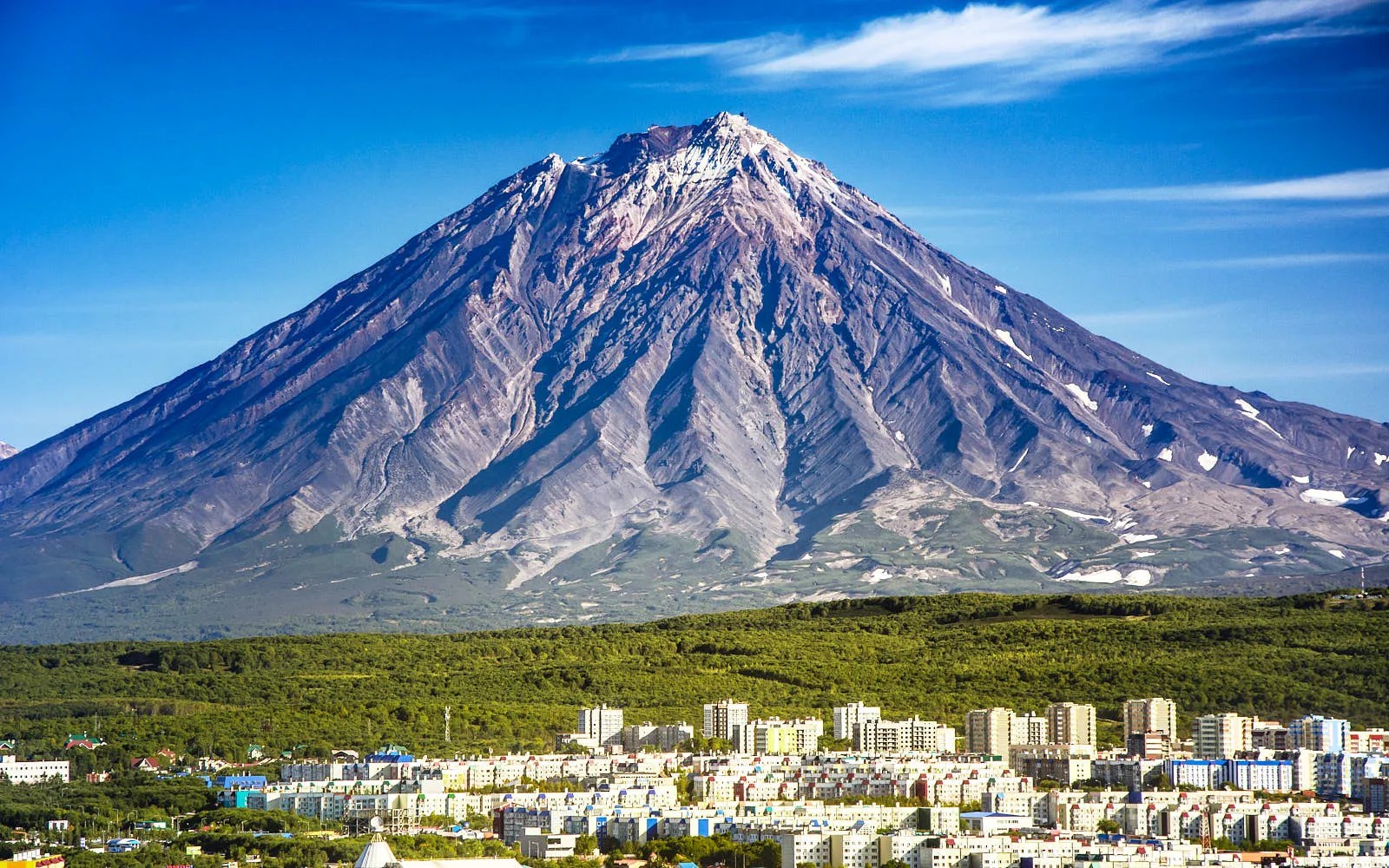
Attractions
Petropavlovsk stretches along Avacha Bay, one of the city’s main attractions. On a clear day, the bay can be seen from all vantage points in the city. Day and night, ships and boats cross it—it’s very beautiful. You may even get lucky and see a submarine entering from the open ocean into Vilyuchinsk, a closed city on the opposite shore of Avacha Bay.
The main walking area of Petropavlovsk-Kamchatsky is located in the historical center—between Petrovskaya and Nikolskaya hills and the port in the Petropavlovsk basin.
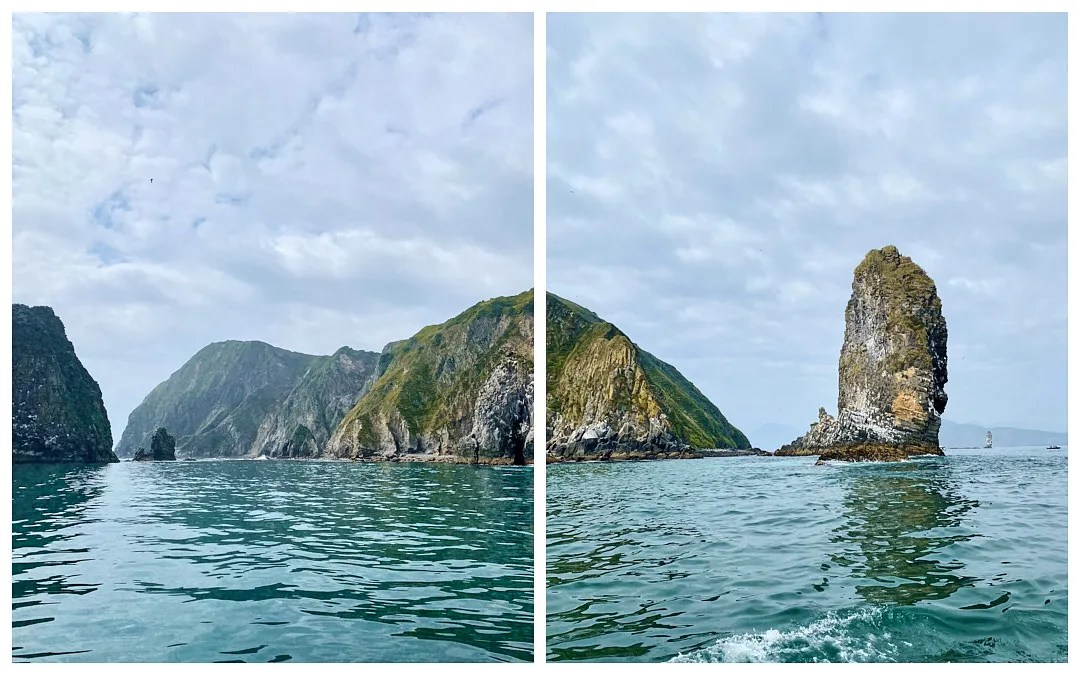
Main streets: Sovetskaya, Leninskaya, Naberezhnaya, and Ozerovskaya spit. Apart from the views, they are noteworthy for the presence of several good cafes (“Kyoto”, “Two Seas, Ocean”, “Baker Street”) and a plethora of charming graffiti (Sovetskaya 22, Leninskaya 38). Walking around Petropavlovsk isn’t very convenient due to the hilly terrain. There’s not much to do in the city itself for more than two days.
Mishennaya Hill (381 meters) can be seen from any point in the city, and you can climb it in less than an hour. From the top, a panorama opens up over a large part of Petropavlovsk, Avacha Bay, and if you’re lucky, the Avachinsky, Kozelsky, and Koryaksky volcanoes. Some tourists climb Mishennaya Hill at sunset to look at the city in the evening lights. But this can be dangerous: at dusk, bears become more active not only in the remote forests but sometimes even in the city.
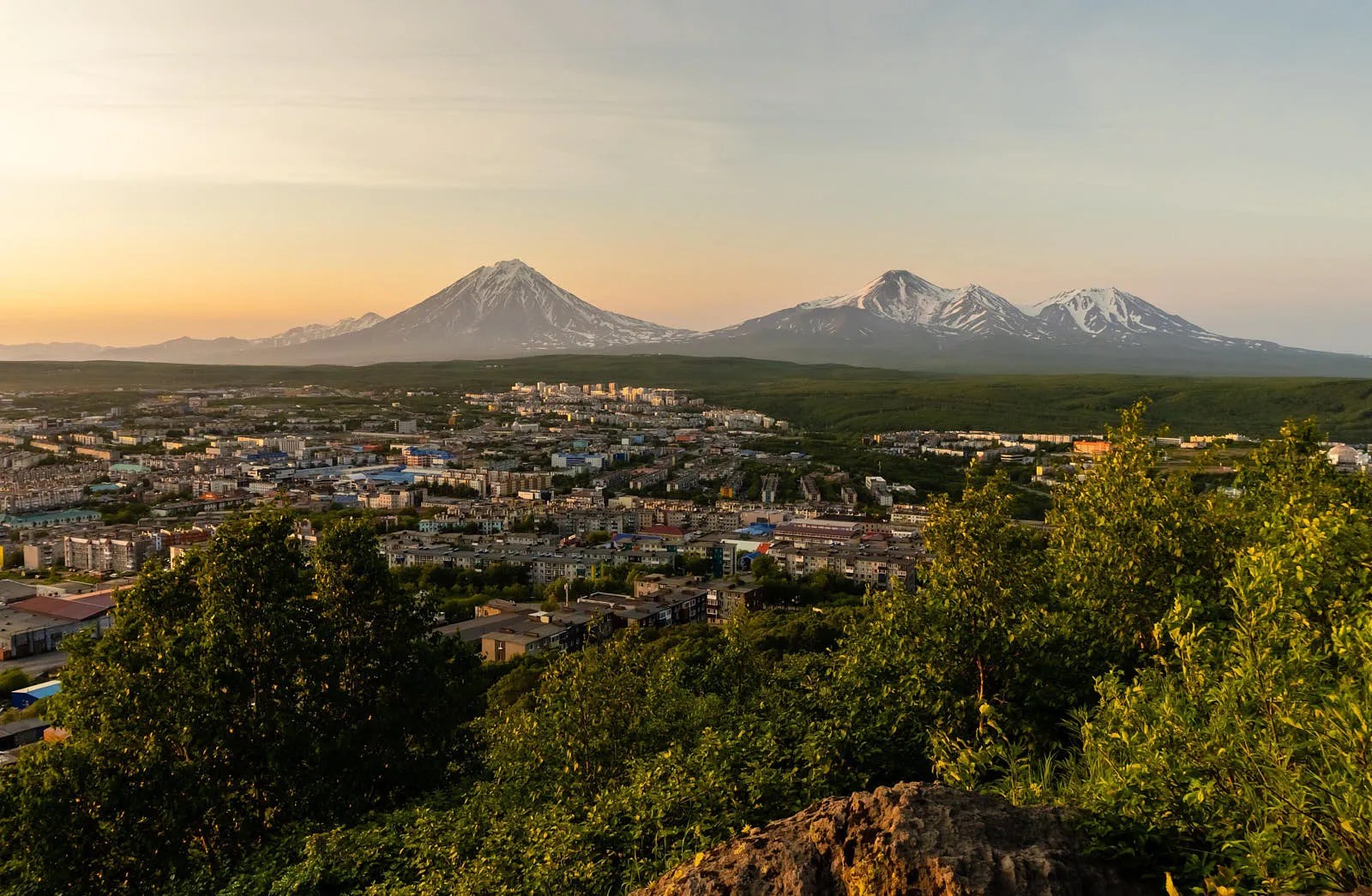
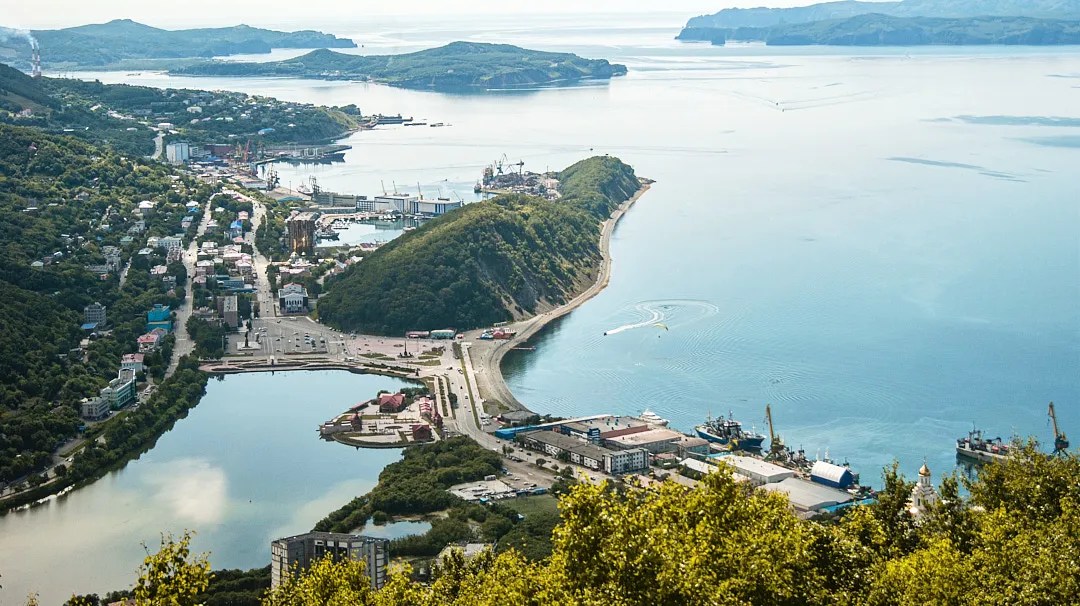
Nikolskaya Hill (103 meters) is located near the central square of Petropavlovsk. It is notable from a historical perspective — it was here that in 1854, during the Crimean War of 1853-1856, the defenders fought against the Anglo-French fleet. Monuments dedicated to the city’s defenders, including a chapel, the “Glory” monument, and an obelisk, are situated on the hill.
“Vulkanarium” is a museum dedicated to volcanoes. Here you can observe simulated eruptions and models of lava flows, and examine samples of rocks. Admission with an audio guide costs 1,000 rubles (10.93 $), or 1,200 (13.11 $) in a guided tour.
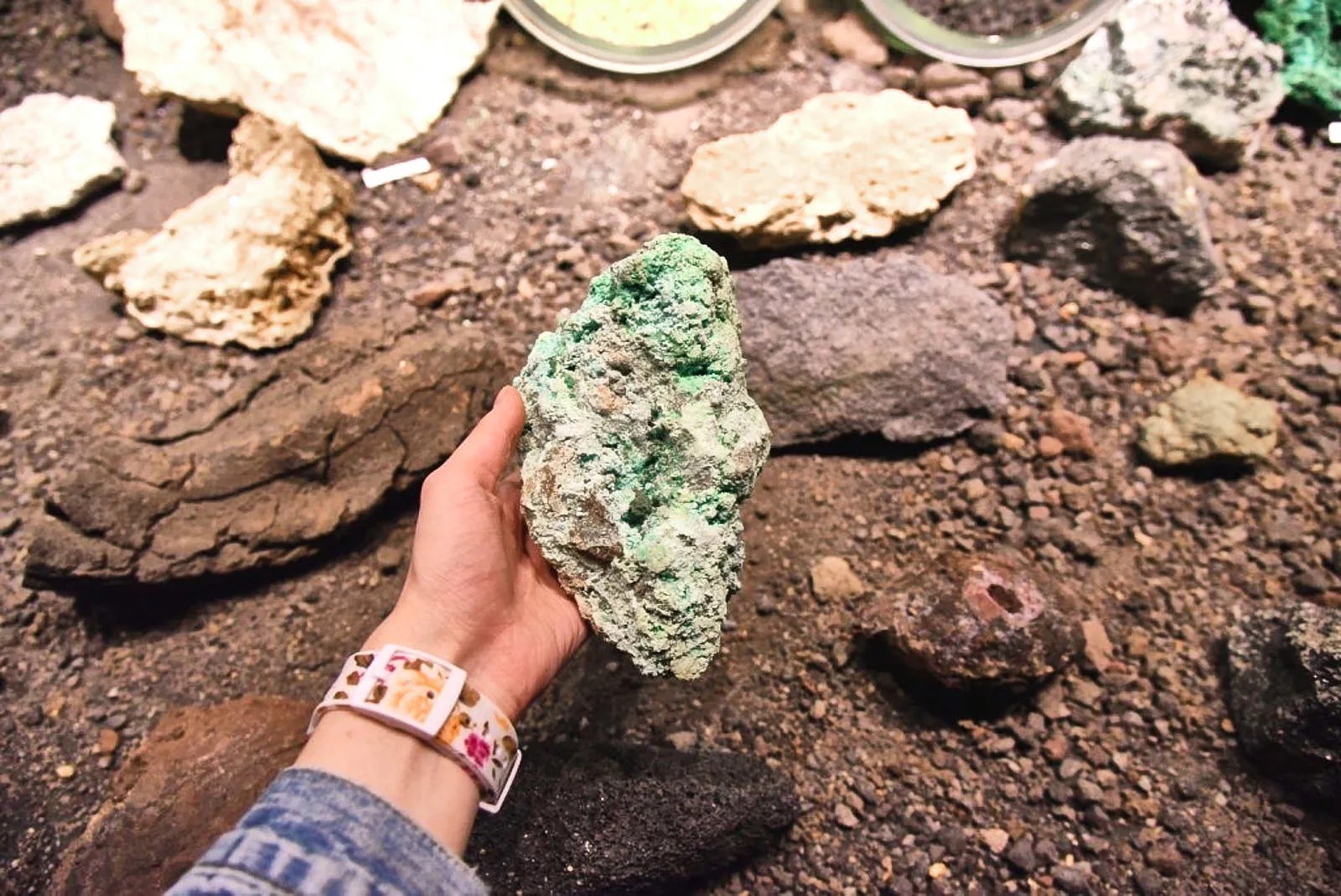
The Local History Museum is a typical museum with an interesting historical exhibition and a souvenir shop. Here you can learn a lot about the peninsula’s development and the capital city, see authentic sundials used by Vitus Bering, and exhibits on Kamchatka’s contemporary fauna.
The “Oceanrybflot” museum is dedicated to fishing in the Pacific Ocean. Exhibits here are modern and interactive. Using visualizations on various screens, you can be on the deck of a fishing vessel and inside a processing plant, participate in quizzes, and familiarize yourself with the habitats of various fish species.

The Avachinskaya Bay Promenade is a pleasant place for a leisurely evening stroll, the sound of waves, a sandy beach, and several cafes where you can grab a bite or have a cup of coffee.
Kamchatsky Rock is not the most popular viewpoint on the southern outskirts of the city. It’s very sparsely populated and you can encounter wild foxes. The climb to the viewpoint takes about an hour.

Local residents go to relax in the Malaya and Bolshaya Lager bays. They are located a ten-minute drive from the city; the water there is calmer and warmer, and there are almost no waves, so you can swim. Keep in mind that the water in Avachinskaya Bay doesn’t get warmer than 20 degrees Celsius in the summer. On the wide sandy beach, there’s plenty of room for sunbathers and volleyball players. And if you get tired of the sun, there are places where you can hide in the shade of trees and have a picnic.

Where to Spend the Night – Which Hotel to Choose?
In Petropavlovsk-Kamchatsky, there are not many good hotels. However, new stylish projects have been opening in nature recently—near thermal springs, at the foot of volcanoes, and on Khalaktyr beach.
- Granin House is a guest house in the city center. On clear days, the rooms offer a view of Avacha Bay, and you can even see Avacha Volcano. You can rent either a studio or a small room. A double room costs 6,000 rubles (65.57 $) per night, and the price includes a hearty breakfast made from local products.

- “Chief of Kamchatka” is a three-star hotel near the central square. The rooms look even better in person than in photos, they serve delicious food, and the hotel administrators assist with all questions. A double room starts at 7,500 rubles (81.97 $).
- Bay House is a guest house located virtually at the foot of Mishennaya Hill, within walking distance of all the city’s landmarks. Rooms are decorated with art objects by the famous artist Ilya Robe. A double room starts at 7,000 rubles (76.50 $), and the price also includes a tasty breakfast.

Hotels in the Surrounding Areas
- “Shiksha” is a glamping site on the shore of the Pacific Ocean. It operates from May to October. Here you can rent a bike and explore the surroundings, steam in a sauna, or simply walk along the ocean’s black sand beach. A night in a tent costs 10,000 rubles (109.29 $).
- Tolbachik Camp—dome tents at the foot of the Tolbachik Volcano—are a real oasis amid a lava desert. The glamping site has a communal kitchen, hammocks, a fire pit area, and a BBQ zone. A dome starts at 4,000 rubles (43.72 $) per night.
- “Kamchatka Forest Lodge” is a park hotel near the Paratunsky springs. Renting a chalet costs 26,000–37,000 rubles (284.15–404.37 $). A room costs 18,000 rubles (196.72 $).
- Kamchatka Campers—for those who have always dreamed of living in a house on wheels with ocean views. The rental cost starts at 10,000 rubles per day (109.29 $).
- Vilyuchik Camp is a glamping site on Vilyuchinsky Pass, offering stunning views of the surrounding nature. The territory has a restaurant, but you can’t cook for yourself. Due to the remote location, there are some nuances: you have to bring your own water and take the trash with you. You also need to bring a sleeping bag or rent one at the glamping site. Electricity is only available during breakfast and until 11:00 PM. The cost of accommodation from July to September is 25,000 rubles (273.23 $) for a 2-3-person Eco-Module and 28,000 rubles (306.01 $) for a 7-person tent; in May-June and October, the same price applies for the Eco-Module and 23,000 rubles (251.37 $) for a tent.
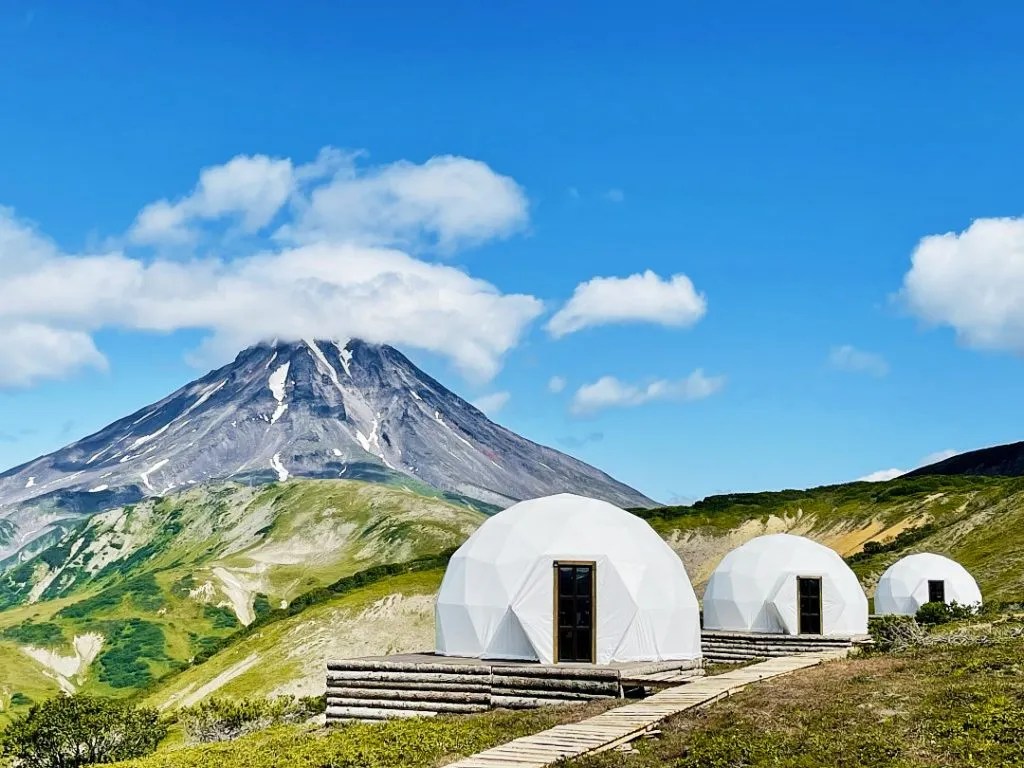
Food in Kamchatka
There’s a widespread belief that food prices in Kamchatka are astronomical. Indeed, some products—fruits, vegetables, beef—are significantly more expensive than their mainland counterparts. The high prices are due to the cost of transporting goods. For example, one kilogram of beef in a supermarket costs around 1000 rubles (10.93 $), a kilogram of bananas—250 (2.73 $), tomatoes—400 rubles (4.37 $). All other products cost either the same as on the mainland or are 10–15% more expensive. Prices are accurate as of June 2023.
Local products—fresh fish and seafood, canned fish, crowberries, blueberries—are significantly cheaper than mainland products. Although they are still not cheap, and it would be costly to eat them every day. Prawns cost 1500 rubles (16.39 $) per kilogram, Kamchatka crab—starts from 1500 rubles (16.39 $), pink salmon roe—starts from 2000 rubles (21.86 $), crowberries—400 rubles (4.37 $). These low prices are mostly from private sellers. Prices at city markets, for example, at the Central Market near Komsomolskaya Square, are significantly higher, especially during peak season.
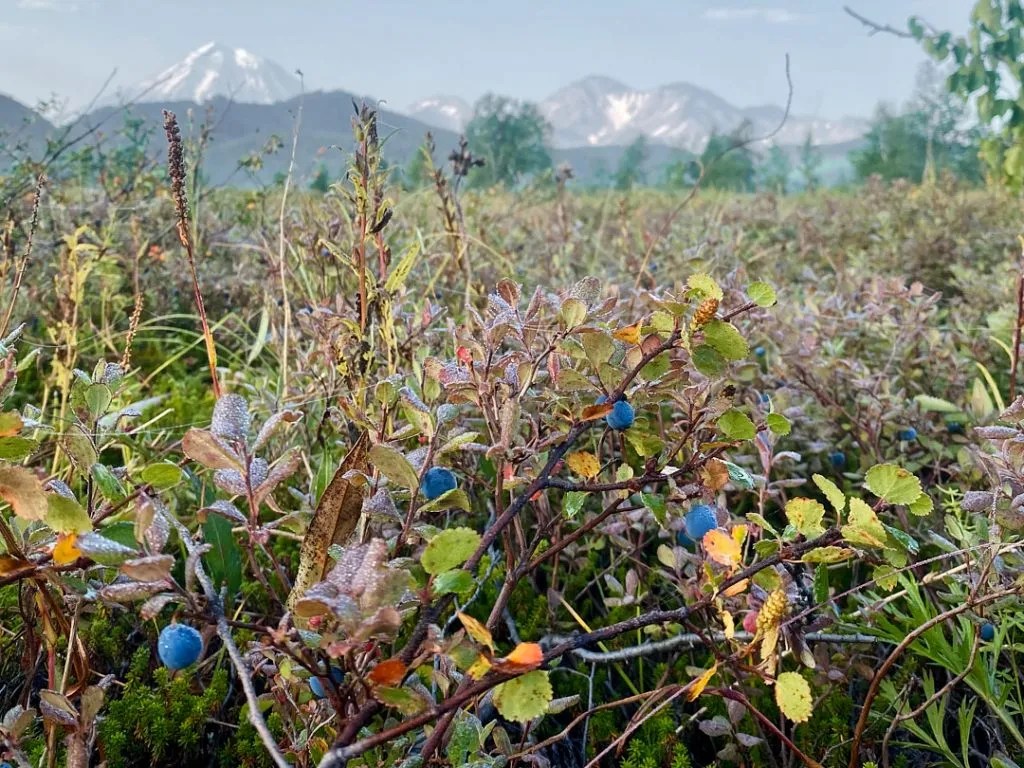
What to bring home
- Red caviar
- Chavycha—this is a fish from the salmon family, rarely found in stores in other regions of Russia. It is unlikely that you’ll be able to bring fresh fish on a plane, so opt for salted or half-smoked, and they will pack it in a thermal bag for you.
- Horsehair crab or Kamchatka crab. Crabs, or, for example, their claws, are sold in a saline solution, so they are also easy to bring on a plane.
- Ivan tea (“Ivan-chay”), plain or with additives (blueberries, dwarf pine, rowan)
- Confiture from kneyazhika. This is a northern berry also known as Arctic raspberry.
- Souvenirs made from bear claws: amulets, pendants, keychains.
- Wooden products: utensils, boxes, statues.
Local people usually buy fish, roe, and seafood through Telegram chats, as market and store prices are inflated, especially during high season. In these chats, you can buy directly from private sellers at lower prices. Examples of chats: “obyavleniya41,” “kamchatka_chat_ru.” They are available only in Russian. In the chats, there are offers for selling products with delivery/self-pickup, and it is safe to order, the main thing is not to pay in advance. You can also find excursions and sea trips from local residents on the “Classifieds Board.”
At the main post office, they sell postcards (which you can send right away) and various artisan products (moccasins, drums, knives, products made from whalebone, woven baskets). “Protect Kamchatka” is a local clothing and accessories brand. Kamcha is a souvenir store: from Christmas ornaments to branded tea.

Tours and Hikes
People mainly go to Kamchatka for active vacations. However, don’t expect the comfort of a five-star hotel from such tours; you won’t find that even for tens of thousands of dollars. Roads in Kamchatka are often unpaved and of poor quality. To reach many attractions, you have to go on foot, live in tents or glamping facilities, where electricity may be available for only a few hours a day, and you have to bring your own water. However, all these difficulties are offset by the incredible nature of Kamchatka.
Independent planning is hampered by logistical challenges: there may simply be no road to a volcano, and you might have to drive, for example, over a lava plateau without tracks or along the bed of a dried-up river. This can be overwhelming even for experienced travelers. It’s also not recommended to set up a small or, especially, a solitary camp outside of organized sites or glampings due to bear attacks. Therefore, it’s safer and easier to trust professional guides and tour organizers—both local and from the mainland.
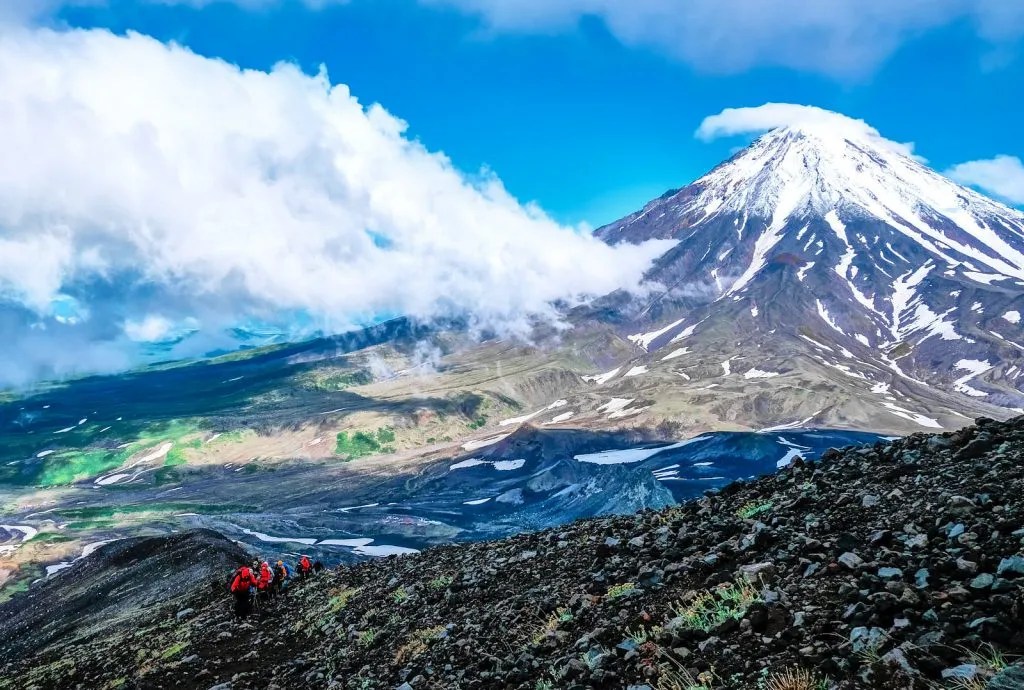
The main part of the hikes includes climbing volcanoes, crossing passes, and trekking through rocky and mountainous terrain. Therefore, when planning your vacation, consider your physical preparation and gauge your strength. The tour company will definitely consult you on any of the routes.
The classic Kamchatka tour offered by various firms is more or less similar and includes visits to Khalaktyrsky Beach, Mutnovsky and Gorely volcanoes, Tolbachik volcano, Vachkazhets massif, and a sea walk. Next popular activities are helicopter tours to the Valley of Geysers, surfing, visiting thermal springs, and climbing Avachinsky volcano. There are also specific tours with heli-skiing, freeriding, kayaking, and climbing Klyuchevskaya Sopka, but they are not designed for the general public.
Local Tour Companies
Listed below are major local tour operators. Many of their websites do not support English, but they are happy to organize tours for foreigners as well.
“Kamchatka” — This local tour operator offers summer and autumn tours lasting 10–20 days, one-day jeep tours, helicopter flights, photo tours, and visits to volcanoes. Multi-day hikes start at 49,000 rubles (535.52 $). A one-day jeep tour costs 10,000 rubles (109.29 $) per seat or you can rent an entire vehicle with a driver for 25,000 rubles (273.23 $).
Kamchatka Freeride Community — They organize not only extreme leisure activities for snowboarders and skiers but also regular tours. They take you to the Valley of Geysers (starting at 260,000 rubles) and to volcanoes and springs for one day (starting at 10,000 rubles / 109.29 $).
Galentina Tour — This local project offers custom hiking routes to Nalychevo and volcanoes starting at 41,000 rubles (448.09 $). Hikes that include easy climbs to volcanoes and salmon spawning observation start at 125,000 rubles (1,366.13 $).
“Adventure Club” — A large Russian aggregator offering various tours, including challenging hikes to the Sredinny Ridge. Prices start at 38,000 rubles (415.30 $) for a 12-day trek.
Russia Discovery — Another major tour operator. They offer individual tours starting at 300,000 rubles (3,278.70 $), gastronomy tours from 200,000 rubles (2,185.80 $), and tours without tents and backpacks from 100,000 rubles (1,092.90 $).
Equipment
Almost all programs require participants to have their own backpack, mat, sleeping bag, and sometimes a thermos and utensils. A mat and sleeping bag can come in handy even if you don’t plan on camping. Even in glamping sites with heating, it can get cold. And some guest houses offer accommodation without mattresses and bedding. Whenever possible, it is better to buy all this in your hometown and test the equipment a few times on short trips before going on a multi-day trip to Kamchatka. Equipment rental in Kamchatka is not as well-developed as, for example, in the Caucasus, and the time spent searching for a sleeping bag is better used exploring the region.
The most important thing is to choose comfortable footwear. Even on a short one-day hike, uncomfortable boots or chafed blisters will ruin all the pleasure of the beauty of volcanoes and the ocean. Trekking boots are appropriate in the fall when it is rainy and during warm summers. Trekking sneakers with good ankle support will also work. But regular sports sneakers, canvas shoes, and other urban footwear are not the best option. Clothing should be quick-drying, ideally covering the skin from insects, the sun, and branches, and comfortable. You will definitely need a windproof jacket, pants, warm socks, headwear, gaiters (covers to protect the lower part of the legs), and a buff (for the face and neck).
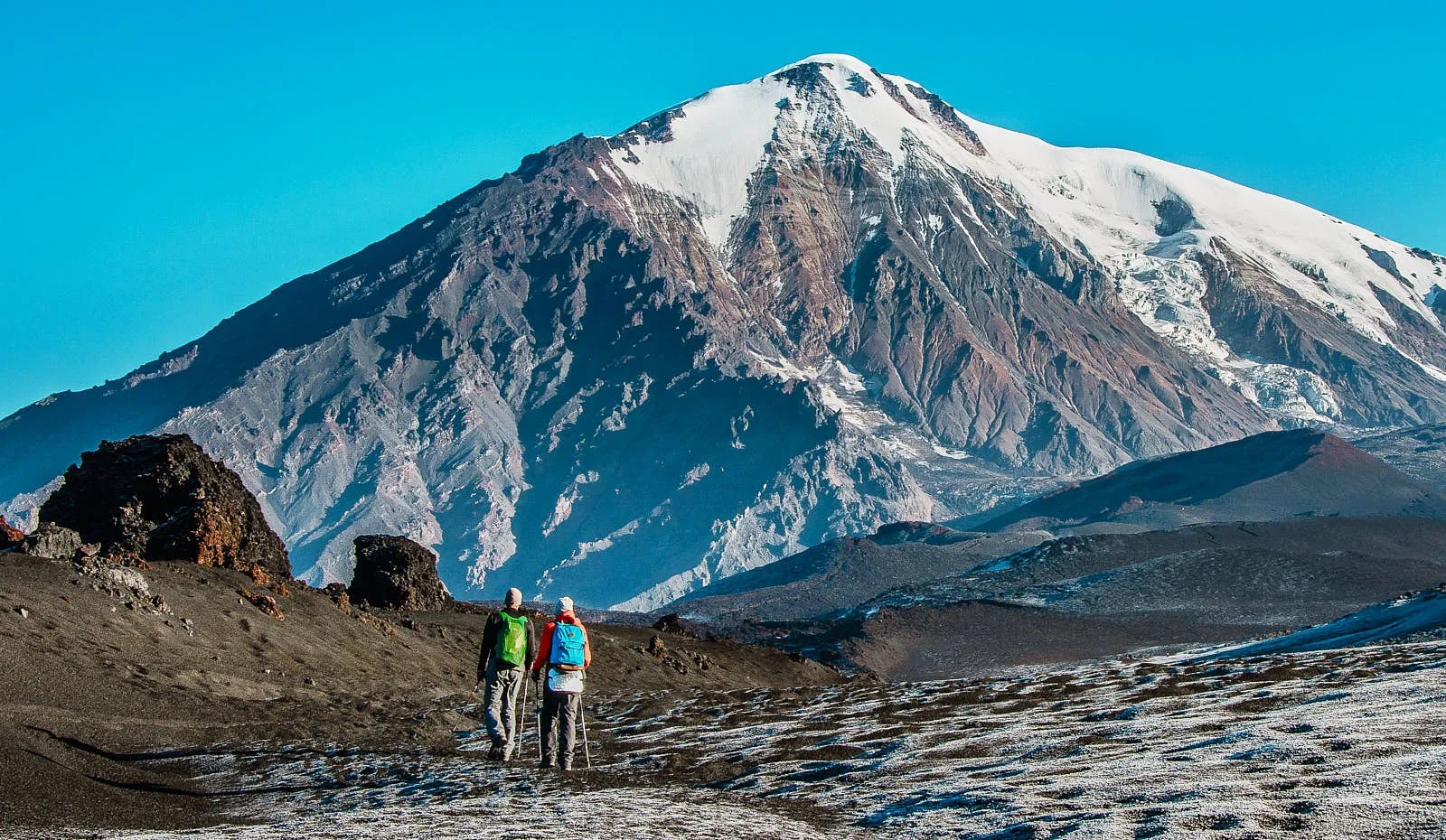
Ocean
Khalaktyrsky Beach
Khalaktyrsky Beach is one of the most popular attractions in the Kamchatka region. It is located 30–50 minutes by car from Petropavlovsk, depending on road conditions, as it is accessible by a dirt road. Public transport doesn’t go to the beach, so the easiest way to get there is by taxi or a ridesharing service. Such a trip will cost around 1,000 rubles (10.93 $) one way. It’s best to plan your return trip to the city in advance, for example, by asking the driver to wait for you for a few hours. If you plan to stay in one of the glamping sites or surf schools, they usually help arrange transportation.
Stretching nearly 50 kilometers, the beach is covered in black volcanic sand. The beach offers stunning ocean views, thousands of seagulls fly around, surfers ride the waves, and those who wake up at five in the morning can enjoy incredible sunrises. On clear days, you can see a panorama of the Koryaksky, Avachinsky, and Kozelsky volcanoes from the beach.

Interesting features—like an abandoned piano right on the shore, wooden idols, and coastal camp tents—are concentrated in the most popular part of Khalaktyrsky Beach near the Snowave and Surfway surf schools.
When visiting the beach, it is recommended to bring water, snacks, and a raincoat, as there are no stores or shelters in case of rain.
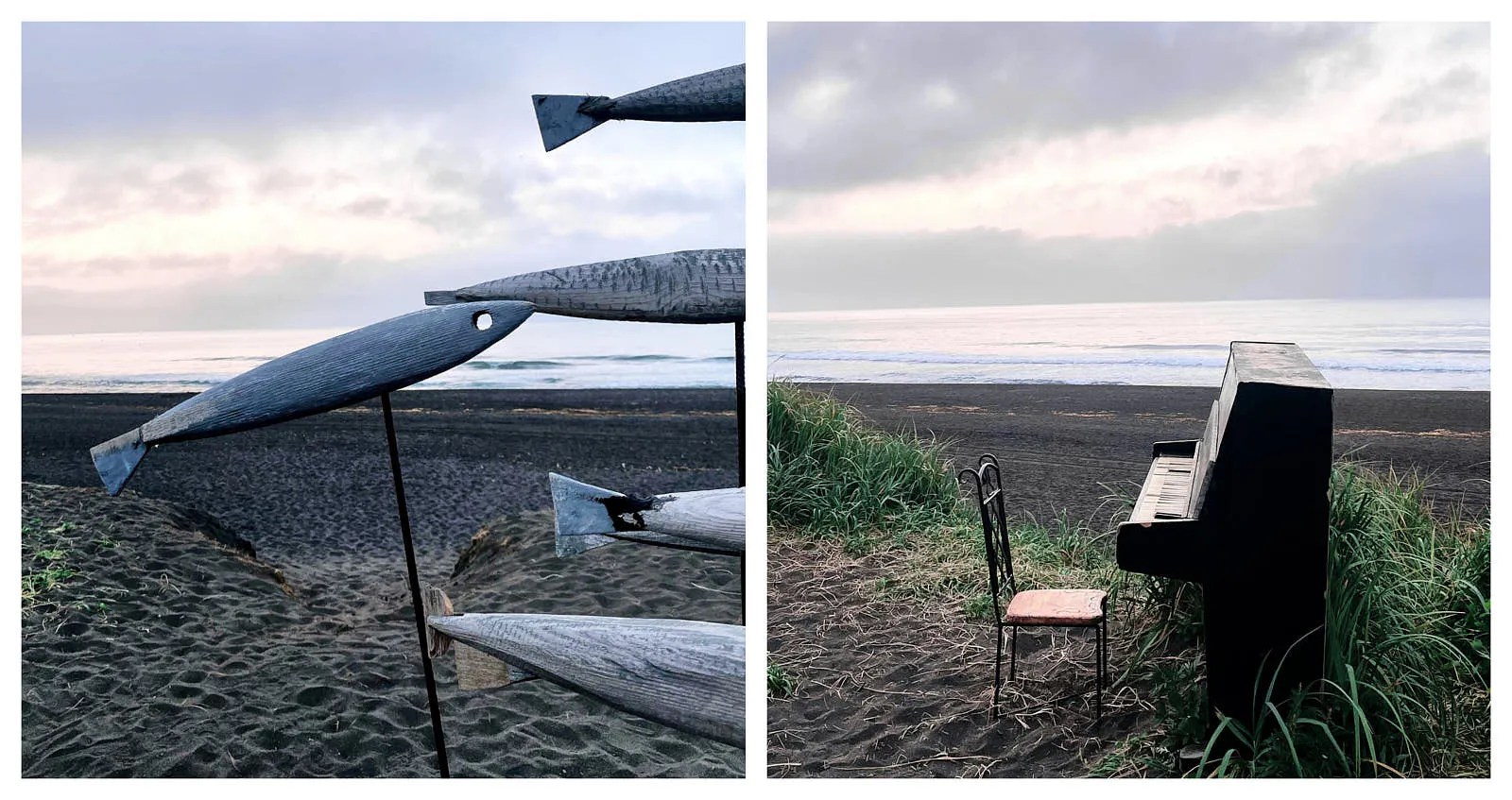
Sea Excursion
Many locals buy small boats and conduct day trips for tourists. You can find their contacts in the Telegram chats we mentioned earlier. From my experience, a 12-hour trip starting in Avachinskaya Bay, visiting Russkaya Bay, fishing in the open ocean, bird watching and observing marine mammals is enough to get a first impression of Kamchatka’s marine nature. Due to bad weather, we couldn’t reach the bay and just cruised around Avachinskaya Guba, saw many seabirds, sea lions, and seals (unfortunately, we didn’t encounter any whales or orcas), had a successful fishing session, and had lunch with the catch: crabs and Greenland halibut.

If you absolutely want to see orcas, whales, and sea lions, it’s better to take a longer excursion. There are two- and three-day options with an overnight stay in Russkaya Bay. You’re most likely to encounter gray and humpback whales, sperm whales, and orcas in Kamchatka’s waters during the high tourist season from July to September.
Prices for sea excursions vary from 5,000 (54.65 $) to 16,000 rubles (174.86 $) per person depending on the duration and richness of the program.
Lately, paddleboards have become popular: you can ride both in a calm bay and in the open ocean. It’s also a great way to experience the ocean.

Surfing in Kamchatka
You’d typically associate surfing with southern beaches of white sand, palm trees, and coconuts with straws. However, you can surf even in the northern latitudes of the Pacific Ocean. Over the last ten years, a whole community of several surf schools has formed at Khalaktyr Beach. Some even surf in winter when the surrounding mountains and the beach are covered in snow.
Waves in Kamchatka are the most stable and suitable for year-round surfing and are considered the best in Russia. Campsites are located opposite the most convenient spots (places where waves, seabed, and current allow for surfing). Surfers from beginners to pros live and train here. Most of these camps operate year-round but are most active from May to October. November waves are rarely suitable due to typhoons, but you can surf in other months.

Even in the warmest months, the water doesn’t get warmer than +13 degrees Celsius. Surf schools provide wetsuits, helmets, boots, and gloves to keep warm. Many schools offer not just accommodations but organized camps with transfers, meals, surfing (with an instructor), and outdoor activities. It’s a fully thought-out vacation, plus a social scene, but it would be hard to call such a holiday “laid-back.”
Most Known and Trusted Surf Schools at Khalaktyr
Snowave was founded in 2009 and is considered the first surfing school in Russia. Pioneers offer services from professional instructors, some of whom (like founder Anton Morozov) have 15+ years of experience. In 2023, they updated their rental gear and now provide tourists with new, cool wetsuits and helmets from top brands like Dakine and O’Neill. A photographer waits onshore during lessons, so you can later see and buy photos of your ride. Snowave offers a wide range of accommodation options: from tents and glamping huts to cozy family-type cabins.
Group lesson (2.5 hours): 5,000 rubles (54.65 $), Individual: 11,000 rubles (120.22 $), For children: 4,000 (43.72 $) and 7,000 (76.50 $). A two-week surf tour with accommodation costs from 200,000 rubles (2,185.80 $).

Quiksilver. Group lesson (4 hours): 5,000 rubles (54.65 $), Individual: 10,000 (109.29 $), surf and wetsuit rental without instructor: 3,000 rubles (32.79 $). Camp with accommodation for 13 days and ten surf lessons costs 162,000 rubles.
Local’s Surf Centre is located next to other surf schools. Book lessons and accommodations from June 16 to October 2. A two-week surf camp costs from 136,000 rubles (1,486.35 $), a 4-hour group lesson is 5,000 rubles (54.65 $), individual 10,000 (109.29 $), a 10-lesson pass costs 42,000 (459.02 $). Equipment rental is 3,000 rubles (32.79 $).
All prices are current for 2023.
Even if you don’t plan to devote much time to learning how to surf, trying it once with a view of the volcanoes is definitely worth it. So choose a school and ride the wave.
National and Natural Parks
One of the features of Kamchatka is a well-developed network of specially protected natural areas (SPNA). This is a rather complex system in a matryoshka format. A single reserve can include multiple national parks, sanctuaries, or other forms of SPNA. There are 121 of them in Kamchatka altogether.
It is precisely on the territories of SPNA where the most visited natural attractions are located, which are included in the programs of tours, hikes, and excursions. If you plan to visit independently, for example, Gorely volcano, you need to get permission in advance to access the natural park “Volcanoes of Kamchatka”. Visiting the territory of Kronotsky Reserve is a more complicated process since it is a federal SPNA and the rules are stricter. That’s why it’s more convenient and comfortable to travel to Kamchatka as part of a tour group where everything will be done by the organizers.

As mentioned earlier, due to long distances, lack of paved roads leading directly to the starting point of the ascent to any volcano, it is better to plan visiting Kamchatka’s SPNA on tourist vans or jeeps, and particularly remote objects by helicopter.
The “Kronotsky State Reserve” is the largest in Kamchatka. It is here that the famous Valley of Geysers is located. You can only get there by helicopter tour, as there are no roads through the surrounding mountain passes. In the Valley of Geysers, there are about 40 geysers that shoot water up to a height of 20–40 meters. Some erupt several times a day, some continuously — tours are planned according to their schedule. Besides geysers, you can see the Valley of Death with toxic fumes and the caldera of Uzon volcano — a huge (9×12 kilometers) basin of a destroyed volcano. All these attractions can be visited on a one-day helicopter tour, costing from 60,000 rubles (655.74 $) per person.

In the South Kamchatka Federal Reserve (part of the Kronotsky Reserve), on the shore of Kuril Lake, lives Russia’s largest population of brown bears—about a thousand animals. One can observe the daily life of bears in their natural habitat even from a close distance. The reserve has special enclosures that limit a small area accessible to visitors. Kuril Lake is also the largest spawning ground for Pacific salmon in Eurasia. Therefore, from July to September, you can witness bears hunting for fish. You can get there by helicopter or off-road vehicle. Information about routes, tour prices, and visiting rules can be found on the reserve’s website.
“Volcanoes of Kamchatka“—in this natural park are the most visited Kamchatka volcanoes: Avachinsky, Vilyuchinsky, Gorely, Klyuchevskaya Sopka, Mutnovsky, and Tolbachik. This area is included in the UNESCO World Heritage list. There are 47 tourist routes laid out. Some are accessible by foot, others only in winter by snowmobile (following the traces of Beringia — dog sledding races). For example, I walked along the forest trail from the central cordon to Talovskie Springs accompanied by a ranger from Nalychevo Park. The hike with an overnight stay and return took three days. Note that beyond the cordons in Kamchatka, you won’t find any amenities, wooden boardwalks, or well-maintained trails. In Nalychevo, you can bathe in healing springs and are very likely to see a bear (on how to behave when encountering a bear—see the “Tips” section). In Bystrinsky, you will encounter diverse landscapes: from taiga to alpine meadows, in Vilyuchinsky—waterfalls and the eponymous volcano, in the biological reserve “River Kol” you can see salmon spawning.

Natural Monument Blue Lakes. You can easily and quickly get here from Yelizovo or Petropavlovsk-Kamchatsky (just eight kilometers away). Tourists go on an easy trek to glacial lakes, which in early and mid-summer are indeed vividly blue due to the melting pure snow.
Volcanoes of Kamchatka
Volcanoes are one of the main highlights of Kamchatka. Some are active (sometimes smoking, like Klyuchevskaya Sopka, for example) and can erupt at any moment, some are dormant (showed activity within the last centuries—Gorely, Shiveluch), some are extinct (haven’t shown activity in the last ten thousand years—Kamen). The exact number of volcanoes is unknown; most sources indicate 29 active and 160 extinct ones.
Travelers see the majestic peaks even while approaching the airport in Yelizovo. A very memorable view of the Koryaksky and Avachinsky volcanoes opens up in good weather on the way from the airport to Petropavlovsk. Not only can you observe the volcanoes, but you can also climb their peaks.

Popular Volcanoes
Gorely (1799 meters). A gentle convenient trail leads to the summit, making it the most popular volcano among tourists. The crater contains a lake with turquoise-colored water. The ascent and descent take about five to six hours. Therefore, it’s better to allocate a full day for the volcano, and on the way back, if there’s time and energy left, you can visit the Spokoiny waterfall.

Mutnovsky (2322 meters). Everything here is like a perfect volcano out of a stereotype: hot gas emissions from fumaroles, thermal springs at the base, a specific sulfur smell, colorful mountain rocks. Jeeps reach the Cross, a point from which you can get to the crater (and the peak, respectively) in an hour. Near the volcano operates the Mutnovsky Geothermal Power Station, using Earth’s internal thermal energy. Super-fit people can climb both Mutnovsky and Gorely volcanoes in one day.

Avachinsky (2741 meters): A more challenging volcano to climb, you’ll definitely need above-average physical preparation, trekking boots, poles, and a good guide. The last eruption was in 2001. While people take day trips to Gorely and Mutnovsky volcanoes, many climb Avachinsky in the dark to catch the sunrise, aiming to descend before bad weather, which often occurs at such heights after noon, sets in.

Tolbachik (3682 meters): No longer part of the day trips from Petropavlovsk because it’s 350 kilometers away from the city. Hiking expeditions use jeeps for a drop-off. This is a whole volcanic complex with two peaks, a dead forest, lava flows, and Martian landscapes. Climbing the Plosky Tolbachik (3085 meters) is accessible for any tourist with average physical preparation and does not require special equipment besides trekking footwear and sportswear. Only experienced hikers and professional mountaineers go to the neighboring Ostry Tolbachik (3682 meters).
Klyuchevskaya Sopka (4753 meters): This is the highest active volcano in Eurasia. The volcano was active in June 2023 but safely so for people and aviation: it spewed lava fountains in the crater. Climbing this peak is only accessible to professional mountaineers.
Thermal Springs of Kamchatka
The underground waters heat up to 20–90 degrees Celsius due to volcanic activity. At the points where they reach the surface, you can take baths in natural pools. There are about 200 geothermal springs in Kamchatka.
The healing effect of bathing in thermal water is possible when undergoing a special course lasting several weeks. However, even a single visit can relax the muscles, recover after an exhausting day, and make you feel rested.
General rules for staying in thermal springs:
- Do not stay in the water for more than 20 minutes at a time.
- Take baths no more than twice a day.
- Entry and exit from the water should be smooth and calm.
- Do not move actively in the spring; rather lie or sit quietly in one place.
- After visiting the spring, it’s recommended to restore your water-salt balance and drink 500–700 milliliters of plain water.
Here are the most popular springs in Kamchatka:
Paratunski Springs (40 kilometers from Petropavlovsk): The most convenient in terms of location and comfort. You can get there from the city in half an hour. They are accessible in any weather and season. There are real pools, loungers, cafes, and changing rooms.
Zelenovski Lakes (50 kilometers from Petropavlovsk): Another well-equipped place with sunbeds for rent, heated changing rooms, and cafes. These springs contain radon, which is considered harmful in some countries. You can relax in comfortable bowls year-round.
Dachni Springs (110 kilometers from Petropavlovsk, but the road is worse than to Malki and travel time is longer): Usually visited after climbing the Mutnovsky volcano to regain strength. They are located at the foot of the Rocky Ridge and consist of unequipped rocky pools in hollows.
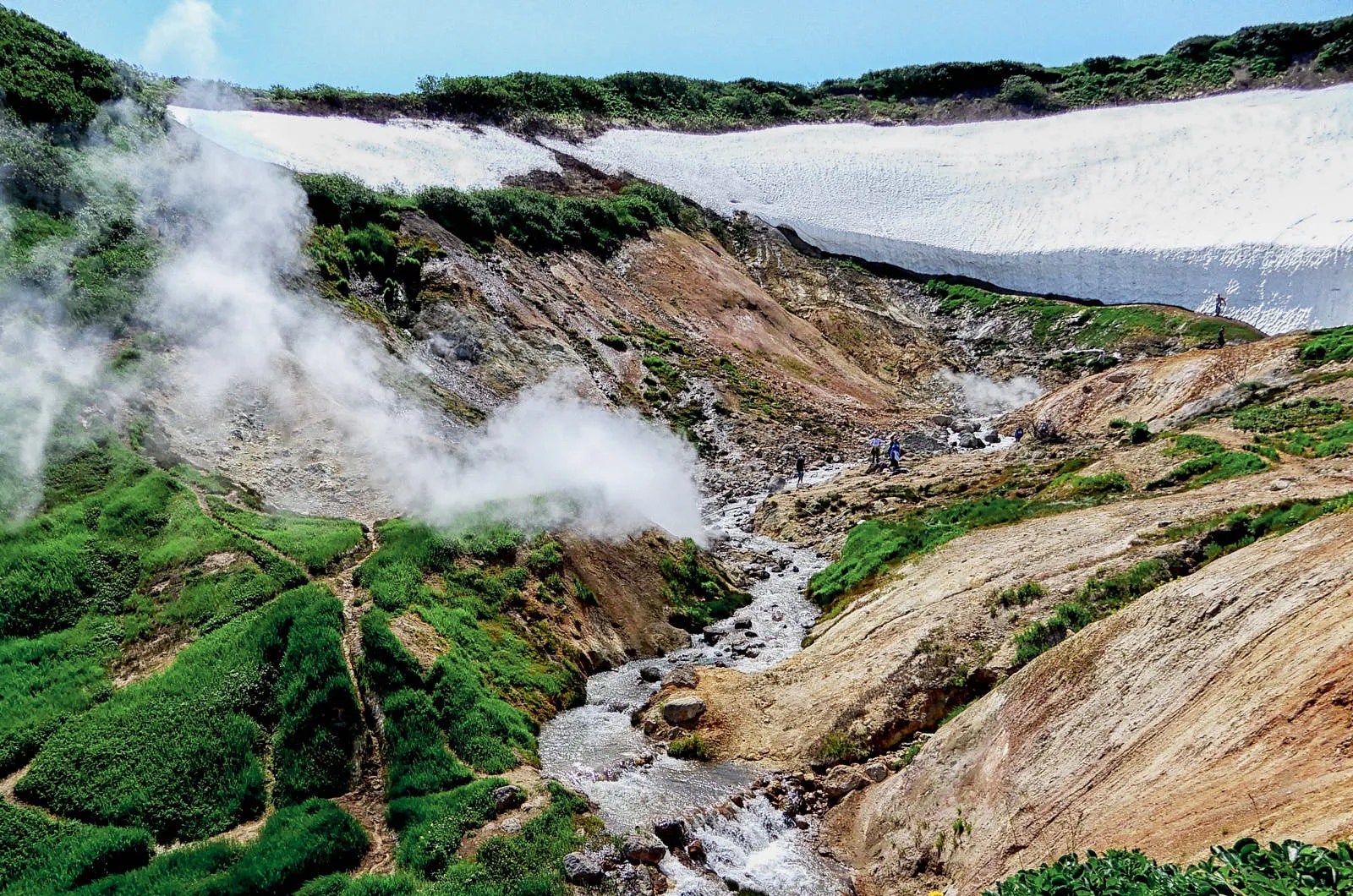
Malkinski Springs (120 kilometers from Petropavlovsk): These consist of unequipped stone pools next to the Kluchevka River. There are six groups of gryphons—this is what they call the emergence of underground waters to the surface. You can alternate between bathing in hot thermal water and in the cool river. The scenery around Malkinski is very picturesque, surrounded by wilderness. However, this leads to a major drawback—large numbers of mosquitoes. Don’t forget to bring repellent. On the way, locals often stop by “Pirozhkovy Ray” café; they sell delicious pastries, and a rating of 4.9 and 650 reviews speak for themselves.
Nalychevo Valley Springs (50 kilometers on foot or 200 kilometers by transport from Petropavlovsk): The road to these springs goes through Avachinsky or sem*novsky Pass. During summer, you can only get there on foot or by helicopter, while in winter, you can use a snowmobile. Many tours to the Valley of Geysers include a visit to these springs on the way back to the city. The valley has over 100 thermal water outlets, which make up seven different groups of springs with varying chemical compositions. The water temperature ranges from +20 to +75 degrees Celsius.

The Nalychevo Valley and Dachni Springs are difficult to access during the winter due to their remoteness from paved roads. Even if you manage to get there by snowmobiles, access to them might be restricted due to snow drifts. On the other hand, Malkinski, Paratunski, and Zelenovski Springs are accessible year-round.
Kamchatka Map
For this text, we have created a detailed map on Google Maps with all the points from this guide.
Transport in the Region
Public transport is difficult to use in Kamchatka due to poor road conditions. Old buses operate between cities and are very slow. Most attractions in Kamchatka are natural, so reaching them by public transport is nearly impossible. Renting your own car is also not always an option due to the bad roads; you may have to cross rivers or deal with severe off-road conditions. Rental Japanese cars (Toyotas) are not always adapted for the mainland; some have the steering wheel on the right, adding to the difficulties of independent travel. Therefore, most travelers, even those who usually plan all their trips themselves, book tours in Kamchatka. Guides will plan the route for you and provide a quality off-road vehicle with a driver.
Ground Transport
There are no railways on the peninsula and the road network is underdeveloped. The main highway is 700 kilometers long and goes from Petropavlovsk-Kamchatsky to Ust-Kamchatsk through Sokoch, Milkovo, Yelizovo, and Kluchi. There are branches to the settlements of Oktyabrsky and Esso. Asphalt roads also lead to Vilyuchinsk and Termalny. Other roads are small and unpaved. Buses operate between major cities, but tickets are more expensive than on the mainland, and the speed is slower. A bus ticket from Petropavlovsk to Esso (500 km) costs from 2800 rubles (30.60 $), and the journey takes about ten hours.
Most excursions and hiking trips start with a ride on a truck-based bus or a powerful off-road vehicle to cross rivers and rocky areas. These vehicles are called “vakhtovka” and were primarily used to transport workers but are now used for tourists. In winter, snowmobiles become the main mode of transport.

Car rentals in Kamchatka are not very popular due to difficult roads, wild nature, and challenging terrain. Whenever possible, use the services of professional drivers and guides. Here are some rental organizations: CarGo, “Forsazh“, and RentCity41. An SUV will cost from 7000 rubles per day (76.50 $), a “Toyota Corolla” from 4000 (43.72 $), and a high-clearance jeep “Toyota Hilux” or “Toyota Prado” from 5000 (54.65 $). The deposit for each car starts at 25,000 rubles (273.23 $). Important: some websites do not include off-road damage insurance in the initial cost. This will be calculated in the final booking or when receiving the car, so consider this when planning your budget.
Air Transport in Kamchatka
Local aviation is well-developed, as reaching remote parts of the peninsula during the off-season can only be done by air. The main regional destinations from Yelizovo are Palana and Ossora (from 60,000 rubles round-trip / 655.74 $), Tilichiki (from 65,000 rubles round-trip / 710.39 $), Ust-Khayryuzovo (from 80,000 rubles round-trip / (874.32 $)). Flights are operated on small domestic airplanes like AN-26/30/32; these have limited seating and the tickets are expensive.
Helicopters fly to most hard-to-reach attractions: the Valley of Geysers, Kuril Lake, Timonovsky Hot Springs, and Lake Khangar. The cost of group helicopter tours starts from 50,000 rubles (546.45 $) per person. Individual tours and helicopter rentals are discussed upon request. Here are some websites where you can place requests: Kamchatka Outdoors, Enjoykamchatka, Vipflot. Helicopters are also used by fans of winter freeriding, fishermen, hunters, and photographers.

Tips
Carefully choose your gear and equipment; don’t skimp on good boots, backpack, and sunglasses. You can read in detail about choosing equipment for hikes here and here.
Get travel insurance and be sure to register with the Ministry of Emergency Situations (MCHS / МЧС) when venturing out independently into the woods, mountains, or for rafting. The easiest way is to submit an online application on the official MES website. This is necessary because the weather in Kamchatka can change suddenly, communication can be lost or is generally unavailable in remote areas, and you may get lost. In such cases, rescue teams will assist registered groups who have shared their approximate route.
In any expedition, the group should always have at least one satellite phone, downloaded area maps, and GPS tracking on multiple devices.
Be prepared for lots of mosquitoes outside the cities in Kamchatka. Good repellents from companies like Gardex, “Raptor”, Mosquitall, and “Taiga” are all available in local supermarkets. A useful accessory for a trip to Kamchatka is a mosquito-net hat for protection against mosquitoes and gnats.
Bears in Kamchatka
Prepare for encounters not only with cute ground squirrels but also with the dangerous brown bear. Here are the main tips when meeting this large predator:
- Do not venture into wild areas alone.
- Do not approach or touch bear cubs — the mother bear will think you intend to harm them.
- Do not walk in the forest in complete silence; it’s better to talk and make noise in a group — this way, the bear will know you’re coming and will most likely avoid you.
- If you suddenly find yourself at an unsafe distance from a bear but it is acting calmly, do not try to do anything — it may start to defend itself.
- Animals are afraid of those who are larger, so gather your group and raise sticks and backpacks above your head.
- Have a flare and a whistle handy for encounters.
- Do not feed the bears and do not leave food remnants in field camps.
- Keep your distance and do not approach the bear for a photo closer than 100 meters.
- Do not turn your back on the bear and do not try to run away from it, as it’s impossible.
- Listen to the advice and commands of the guide.

How to Get to Kamchatka
Plane: Direct flights are available only from Russia: from Moscow, Vladivostok, Novosibirsk, Khabarovsk, Magadan, and Irkutsk. A flight from Moscow takes about nine hours. If long flights tire you out, you can buy a ticket with an extended layover in Novosibirsk or Irkutsk.
When purchasing tickets to Kamchatka from Moscow, the rule “early-bought tickets are often cheaper” does not apply. Half a year before the high summer season, tickets are the most expensive. However, subsidized tickets from Aeroflot become available in early May. A round-trip ticket with luggage starts at 20,000 rubles (218.58 $). In June, tickets for July cost from 29,000 rubles (316.94 $), for August from 40,000 (437.16 $), and for September from 29,000 (316.94 $). The highest demand is in August, the warmest and least rainy month.

Transport from the Airport: All flights arrive at Elizovo International Airport (as a joke for 2023 – there are no international flights), which is located in the city of the same name 30 km from Petropavlovsk-Kamchatsky. Buses and minibuses — №7, 8, and 104 — run to the city center. The fare is 25 rubles (0.27 $).
Taxis cost from 700 rubles (7.65 $) upwards. A trip via Yandex.Taxi will cost around 900 rubles (9.84 $) on average. It is better to use the popular Kamchatka app Indriver, where you propose the price for the trip, and drivers accept your offer. You can negotiate a lower price than in a regular taxi or Yandex.
By Land: Due to the complex terrain, harsh weather conditions, and the simple lack of roads, you can only reach Kamchatka by land within the framework of an expedition in jeeps or on foot.
Ferry: Ferries operate on only one route: Petropavlovsk-Kamchatsky — Severo-Kurilsk (Sakhalin). The journey takes eight hours, and ferries run every three to four days. A ticket costs 4,300 rubles (46.99 $) and can be purchased online at rfbus.ru.
When to Visit Kamchatka
The high season in Kamchatka starts in July and lasts until October. It is during this time that you can easily access all the main attractions without having to deal with snow drifts and prolonged autumn rains. In June, this region still experiences sub-zero nighttime temperatures, which return again in mid-October. Another downside in spring and June is aggressive bears, still hungry after their winter hibernation. Therefore, if you plan on camping or staying in glamping sites, climbing volcanoes, or visiting national parks, come to Kamchatka from mid-summer to early October.
If you want to catch the golden autumn, aim for the second half of September when the volcanic slopes, locally known as “sopki,” turn yellow and red.

If the main purpose of your trip is surfing, suitable months are from May to mid-October when all Kamchatka surf camps are open, and the water warms up to 13–18 degrees Celsius. Surfing is possible year-round, even in winter. Perhaps winter surfing with a view of snow-covered sopki will be the most vivid experience of your life.
Another reason to visit Kamchatka in winter is skiing. There are several organized skiing spots with trails for snowboarders and skiers, for example, Mount Moroznaya or the “Alpina” base. For advanced athletes, freeride tours are conducted in wild conditions—using snowmobiles or helicopters.

Pros and Cons
Kamchatka is a unique region where you can see unusual natural phenomena, Martian landscapes, and encounter wild animals.
Pros
- Nowhere else in the world will you find volcanoes, ocean beaches, geysers, and mineral springs so close to populated areas.
- Active recreation in a not-so-popular tourist destination, so most attractions will be relatively uncrowded.
- Affordable subsidized flights by Aeroflot.
- The opportunity to try fish, caviar, and seafood.
- Absence of oppressive heat and humidity in the summer.
- The chance to try your hand at climbing and extreme sports like surfing and snowboarding.
Cons
- Expensive vacation, the cheapest tour (not entirely on foot, with a moderate level of comfort) will cost around 100,000 rubles (1,092.90 $) without the cost of tickets.
- High prices for some familiar products.
- Long flights, time zone changes, and acclimatization.
- During peak months, excursions, tours, and good accommodations must be booked well in advance.
- Unpredictable weather— for example, helicopter tours may be postponed for several days due to wind or precipitation.
- Independent nature trips without guides are not very accessible.

- Text and Photo: Anastasia Yurlova.
- Cover: Daniil Silantev.
Click to rate this post!
[Total: 9 Average: 4.9]
Related posts:
- The Vertical Grain Elevator (Silo) in Samara — A Benchmark of Brutalist Architecture
- Paleontological Museum in Moscow: A Brutalist Marvel Shaped Like an Ancient Fortress
- Russia Launches E-Visa for Citizens of 55 Countries
- Samara Travel Guide